Sage (Salvia)
By Debs Cook

History
The name Salvia derives from the Latin 'salveo', which means to heal. Sage is prized in many cultures for its healing and medicinal properties, which include antiseptic, digestive, and antibacterial uses to name a few.
The Romans considered sage to be a sacred herb and held highly elaborate ceremonies for its planting and harvesting. A sage gatherer would have a ceremonial bath to ensure his feet were clean and pure before walking on the earth where the sage grew. After bathing, offerings of bread and wine would be made to the soil before finally harvesting.
Native Americans used sage as a toothbrush and toothpaste all in one. They simply rubbed a fresh sage leaf on their teeth to clean the teeth and freshen their breath. Sage's antibacterial properties would have been beneficial in this process.
There is an often-quoted saying, I believe that it has Greek origin, 'How can a man die when sage is growing in the garden?'
Sage was one of the most important medicinal herbs of Medieval Europe. It was believed to have the power to cure all imaginable diseases so no self-respecting Apothecary's Garden could be without it. In the Middle East, it was thought to improve intelligence, and the American Colonialists used sage to cure epilepsy, insomnia, measles, seasickness and worms.
Folklore
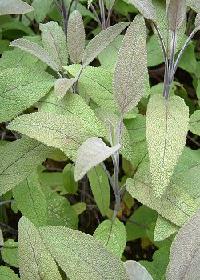
Salvia Officinalis 'Purpurea'
Sage symbolizes domestic virtue, wisdom, skill, esteem, longevity, good health, and brings protection.
To be "sage" means to be wise, this term comes from the belief that sage was thought to impart wisdom and improve memory. The English herbalist, Gerard wrote that "Sage is singularly good for the head and brain, it quickeneth the senses and memory, strengtheneth the sinews, restoreth health to those that have the palsy, and taketh away shakey trembling of the members."
Gardening folklore tells us that the wife will rule the household when sage flourishes in the garden, and that sage will flourish or not, depending on whether the household's business prospers or fails. Old wife's tales say that it is bad luck to plant your own sage and that a bed of sage alone will bring forth ill luck, but adding it to a mixed herb bed will make all right with the world.
It is said that toads love sage, though exactly how they know that fact bemuses me!
Description
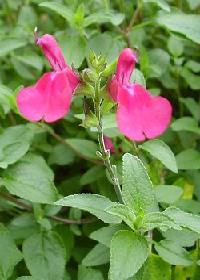
Salvia Microphylla
Sage is actually a member of the mint (Labiatae) family and is a rather sturdy plant with varieties that are annual, biennial, and perennial. It is a decorative herb with attractive foliage that varies in color from silvery grey, cream, yellow and varied shades of green and purple. The flowers of sage plants, which appear in mid-summer, are exceptionally attractive and come in a variety of colors; purples, blues, whites, and a broad spectrum of reds from pink to deepest scarlet. Examples are broad-leaved sage (salvia officinalis) which has purple flowers, pineapple sage (salvia rutilans) which has beautiful scarlet flowers that bees adore, blackcurrant sage (Salvia microphylla) which has beautiful Fuschia pink flowers and, finally, white flowering sage (salvia officinalis 'albiflora').
Sage plants can grow in height from 15cm to 1.5 meters with a spread of 45cm or more. They can be anything from compact little plants to large specimen shrubs, dependant on the variety.
There are in the region of 750 different types of sage, with a wide variety of leaf shapes from narrow lavender-like leaves to almost heart-shaped.
Sages have many possible aromas to match their colors and leaves. These vary from the traditional strong camphor scent to fruity scents such as pineapple, tangerine, and blackcurrant. There is even a sage that smells like eucalyptus (salvia blancoana).
Growing
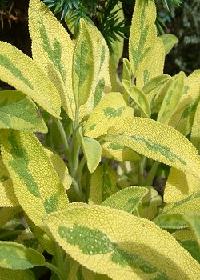
Salvia Officinalis 'Aurea'
Sage prefers a sunny location with dry, alkaline soil. It grows best in a warm climate but will withstand English winters if protected from the frosts.
You can propagate sage from summer cuttings taken with a heel or by layering established branches in spring and autumn.
To grow from seed, plant seeds in a container and place them on a sunny window sill. Place the seeds 5mm deep in the soil, and water. Be sure to keep the soil moist, but not too wet, while you wait for the seeds to germinate. You should see seedlings in about 14 to 21 days. After several weeks, thin out the seedlings and select the strongest ones for planting out in the garden or in containers. You should have large enough leaves to pick and use some in cooking a few weeks after that.
Keep the plant well pruned to encourage young shoots with a strong flavor. Pruning also keeps the plants from becoming leggy and twiggy. If you are growing for culinary uses, be sure to pinch out any flowers in order to encourage the tasty leaves.
Preserving
Fresh sage leaves should be aromatic and have no soft spots or dry edges. Wrap in paper towels and store in a plastic bag in the refrigerator to use within 4 to 5 days. Fresh leaves may be covered in olive oil and stored in the refrigerator for up to 2 months. Use the flavored oil for sautéing or in salad dressing. To freeze fresh sage leaves, wash and pat dry, remove leaves from the stems, and pack loosely in freezer bags to freeze up to 1 year.
Many cooks prefer to use dried rather than fresh sage. Dried sage comes in the whole leaf, rubbed or ground form. Rubbed sage has a light, velvety texture, whereas ground sage is more of a free-flowing powder. As with all dried herbs, store closed containers in a cool, dry place away from sunlight and use them within 6 months for the best flavor.
To dry sage yourself, put it in a paper bag, with holes for air circulation. Protect from dust and other pollutants and hang up in a warm dry place to dry. Once dry crumble the leaves into a dark glass jar and store them in a cool dry place out of direct light. Unlike many other herbs, the flavor of sage increases with storage.
General Use
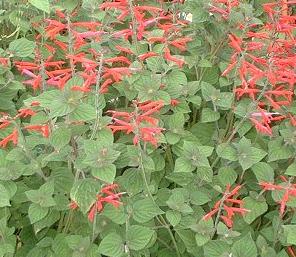
Sage can be used for dyeing wool and fabrics by using the tops of the plant only. Using different mordents gives a variety of colors. You get a yellow-buff color when an alum mordant is added, yellow when a chrome mordant is added and greeny-grey when an iron mordant is added.
As well as its culinary and medicinal uses detailed below, sage can be used in cosmetics for fragrance, as an insect repellant, and makes an excellent hair rinse for dark hair. Sage was also one of the herbs used for strewing in medieval times.
Culinary Use
Sage adds a special flavor to biscuits or scones, as well as bread (see recipe below). It is most famed for sage-and-onion stuffing which accompanies chicken, turkey, and roast pork dishes across the UK. Try covering a pork roast with sage leaves before roasting. When roasting chicken or turkey, use your fingers to gently separate the skin from the breast meat. Then rub a little butter on the breast and under the skin and push a small sprig or two of sage. Pat down the skin, then roast and enjoy. 'Sage Derby' cheese, which hails from where I live, is marvelous with beer, pickles, crusty bread, and salad for a herby plowman's lunch.
Medicinal Use
Because of its antiseptic qualities, sage tea is used as a gargle for a sore throat and is excellent for treating colds, mouth ulcers, and sore gums. To make a tea to ease a sore throat, pour a cup of boiling water over two teaspoons of fresh sage leaves, steep for ten minutes, and add honey to taste. When using tea as a gargle for sore throats, allow it to cool till just warm. For colds, sip the tea slowly.
Sage contains relatively high levels of thujone but heating sage to make an infusion eliminates much of the chemical, so the risk from medicinal amounts is negligible. Do not take sage if you are pregnant, lactating or if you have a fever.
Cosmetic Use
Sage (Salvia Officinalis) extract is a natural antioxidant used in organic skincare products for its toning, astringent and anti-inflammatory action. It soothes irritated skin, protects it from oxidative stress, and promotes regeneration. Thanks to its antibacterial properties, Salvia Officinalis extract is an ideal preservative, prolonging the shelf-life of the product.
Recipe
Sage-and-Onion Bread (made with a breadmaker)
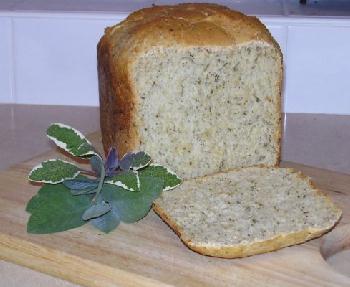
I don't have time these days to make bread from scratch but I do make bread using my breadmaker. The recipe that follows is for a breadmaker but it can be adapted for making the bread by hand. I use dried minced onion in this bread, as a fresh onion has a tendency to make the bread go soggy. The dried onion gives a wonderful flavor and the aromatic touch of sage turns this bread into something special. Use in sandwiches and to make tasty beans on toast. Leftovers can be used to make stuffing.
Ingredients
- 1¼ cups (285 ml) cold water
- 2 Tbsp olive oil
- 1 Tbsp granulated sugar
- 1½ Tsp Salt
- 6 Tbsp dried minced onion
- 2 Tsp dried sage
- 3 Cups (450g) strong white bread flour
- 1½ Tsp easy bake yeast
Method
- Put the ingredients into the bread maker pan in the order specified for your particular model (see your manufacturer's handbook).
- Set to the basic white program.
- Once cooked carefully shake the loaf from the bucket and stand the right way up on a wire cooling rack.
